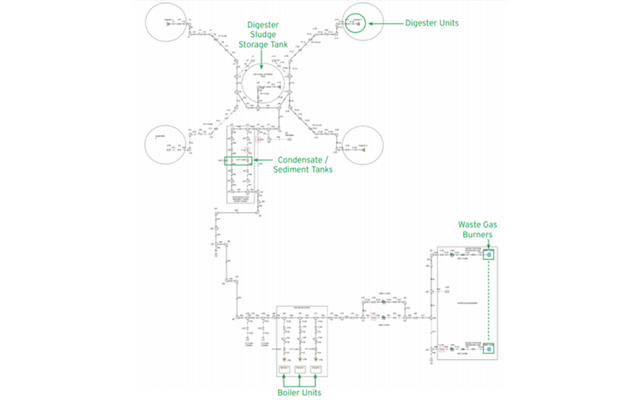*Note to readers:*
This AFT Arrow case study is part of a 2-part case study by Tyler Knight of Brown and Caldwell. The additional part was created in AFT Fathom where a model was created to determine if existing pumps and boilers could maintain heat reservoir loop flow and temperature if the system was expanded. This AFT Arrow case study looks at the digester gas that was claimed from the digester units. While the two models work independently of each other, it is a great reflection of how companies around the world utilize multiple AFT products to reach end goals.
Tyler Knight of Brown and Caldwell was asked to model and analyze an anaerobic digester gas system. The goal was to determine the pressurization effects of adding two additional digesters as part of the wastewater treatment plant expansion project. The analysis would help determine if the increased flow from the additional digesters would over-pressurize the existing digester gas system.
This was the third phase of a wastewater reclamation plant expansion project and Knight’s team inherited old excel calculations from when the system was built in 2004 that were difficult to follow, tedious, and prone to mistakes. The team set out to re-model the system with both current reliability and future expandability in mind. With the next phase of the expansion scheduled to begin a few years out, Knight wanted to ensure the next engineer could easily understand and make modifications to calculate any new system parameters.
The digester gas, a combination of mostly methane (61% by volume) and carbon dioxide (38%), is the byproduct of municipal wastewater sludge from three wastewater treatment plants. The digester gas is collected and flows through a piping system to a boiler building where it is used as fuel in three boilers. What is not utilized by the boilers travels to waste gas burners and is flared off. At the time of this case study, the gas is solely used for the boilers; however, the digester gas system has been designed with provisions to accommodate a potential cogeneration system in the future. Knight had utilized AFT’s Chempak fluid database to define the digester gas mixture to accurately capture the gas fluid properties as the gas undergoes temperature and pressure changes. The model itself was a single-phase system (Figure 1).
After he modeled the system, Knight analyzed data collected from three simulation scenarios. His first scenario simulated the system as it is predicted to run. The second simulation reflected the system with normal operational flow from the digester units but no boilers operating and normal flow to the waste burners. The final scenario reflected the worst-case scenario to determine the maximum digester operation pressure with no flow returning into the storage tank, no boilers operating, and the maximum flow through the waste burner units. During the worst-case scenario simulation, Knight identified the pipes max flow capacity to be 1,250 ft³/ min (35.4m³/min) and they would need a minimum of 4 inches (10 cm) of water column at the waste gas burner inlets. The AFT Arrow model predicted the digester set point pressure to be 22 inches (56 cm) of water column with relief valves opening at 30 inches (76 cm) of water column. This would provide a safety margin of 8 inches (20 cm) of water column before the digester gas would be vented.
With the AFT Arrow model, Knight was able to successfully model and simulate the additional digester units for the treatment facility’s expansion as well as provide the project’s future engineers with an accurateand reliable system model.




